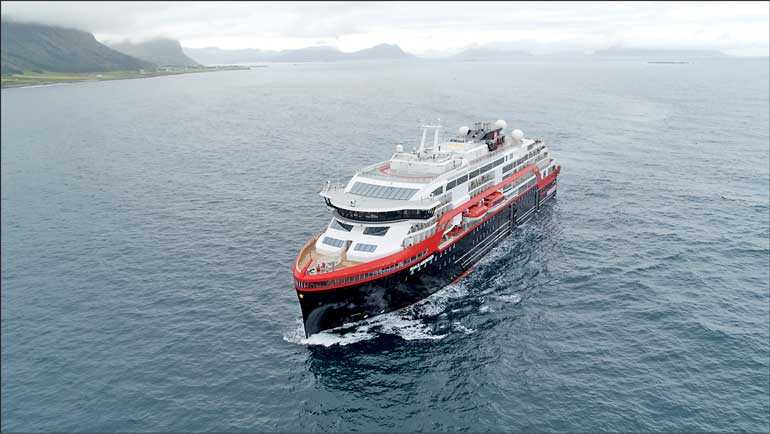Friday Mar 07, 2025
Friday Mar 07, 2025
Wednesday, 3 July 2019 00:00 - - {{hitsCtrl.values.hits}}

OSLO (Reuters): The world’s first cruise ship propelled partially by battery power is set to head out from northern Norway on its maiden voyage, cruise operator Hurtigruten said on Monday.
The hybrid expedition cruise ship, the Roald Amundsen, can take 500 passengers and is designed to sail in harsh climate waters.
Named after the Norwegian explorer who navigated the Northwest Passage in 1903-1906 and was first to reach the South Pole in 1911, the ship heads for the Arctic from Tromsoe this week and will sail the Northwest Passage to Alaska before heading south, reaching Antarctica in October.
While the engines run mainly on marine gasoil, the ship’s battery pack enables it to run solely on batteries for around 45 to 60 minutes under ideal conditions, Hurtigruten Chief Executive Daniel Skjeldam told Reuters.
The company estimates that the battery pack will reduce fuel consumption and save about 20% in carbon dioxide emissions, compared to if the ship was operating on marine gasoil alone.
“It’s designed to take excessive energy from the engines and put into the battery when the ship doesn’t need it, and put it back into the engine when the ship needs it – it is a way of reducing emissions significantly without having charging stations available,” Skjeldam said.
The company, which operates scenic cruise lines along the country’s fjords and into the Arctic, was inspired by Norway’s fleet of hybrid ferries and also its growing fleet of electric cars, he said.
Battery technology for propelling ships is in its infancy, even on shorter routes, as few ports provide charging stations.
“We expect batteries to be an important part of shipping in the years to come, but of course we don’t expect our ships to be able to operate only on batteries, because the ship can sail up to 18-20 days in areas where there are no charging points,” Skjeldam said.
Hurtigruten expects infrastructure will improve on its traditional routes along the Norwegian coast, while currently charging services are only provided in Bergen, Norway’s second-largest city.
The future for batteries on larger ships also hinges on suppliers’ capacity to develop lighter, more powerful systems.
“We expect a revolution on battery technology for ships, we expect batteries to be lighter, more effective, and we’ve set aside extra room for more batteries to be installed when battery packs become more effective,” Skjeldam said. He added that the second hybrid cruise ship the company has on order, to be delivered later this year, will have battery pack with twice the capacity of the Roald Amundsen.
Discover Kapruka, the leading online shopping platform in Sri Lanka, where you can conveniently send Gifts and Flowers to your loved ones for any event including Valentine ’s Day. Explore a wide range of popular Shopping Categories on Kapruka, including Toys, Groceries, Electronics, Birthday Cakes, Fruits, Chocolates, Flower Bouquets, Clothing, Watches, Lingerie, Gift Sets and Jewellery. Also if you’re interested in selling with Kapruka, Partner Central by Kapruka is the best solution to start with. Moreover, through Kapruka Global Shop, you can also enjoy the convenience of purchasing products from renowned platforms like Amazon and eBay and have them delivered to Sri Lanka.
Discover Kapruka, the leading online shopping platform in Sri Lanka, where you can conveniently send Gifts and Flowers to your loved ones for any event including Valentine ’s Day. Explore a wide range of popular Shopping Categories on Kapruka, including Toys, Groceries, Electronics, Birthday Cakes, Fruits, Chocolates, Flower Bouquets, Clothing, Watches, Lingerie, Gift Sets and Jewellery. Also if you’re interested in selling with Kapruka, Partner Central by Kapruka is the best solution to start with. Moreover, through Kapruka Global Shop, you can also enjoy the convenience of purchasing products from renowned platforms like Amazon and eBay and have them delivered to Sri Lanka.